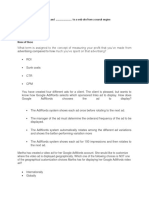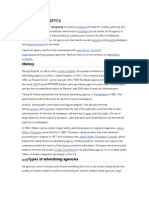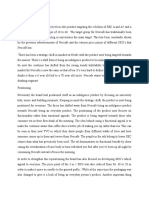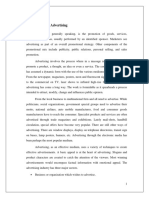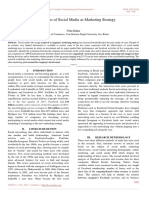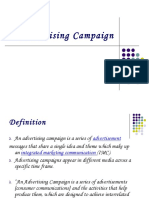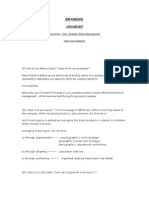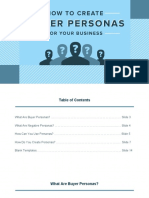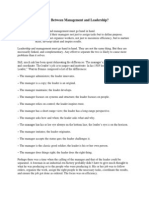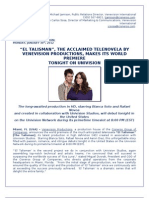Advertising Agency
Advertising Agency
Uploaded by
kareenCopyright:
Available Formats
Advertising Agency
Advertising Agency
Uploaded by
kareenOriginal Description:
Copyright
Available Formats
Share this document
Did you find this document useful?
Is this content inappropriate?
Report this DocumentCopyright:
Available Formats
Advertising Agency
Advertising Agency
Uploaded by
kareenCopyright:
Available Formats
ADVERTISING AGENCY Advertising is an organized method of communicating information about a product or service which a company or individual wants to sell
to people. It is a paid announcement that is conveyed through words, pictures, music and action in a medium which is used by the prospective buyers. To some, advertising is communication with express aim of selling a product or service. Advertising agency is a communication institution that organizations use. Its a facilitating institution of the advertising industry. It helps the advertiser in the creation and production of advertising. They provide a full range of services to advertisers, from the conception of an idea to the exposure of printing the advert. HISTORY Advertising history runs parallel to the history of mankind. Prior to the invention of the printing press (1450 AD), there were town criers who sold their goods through shouting. This simple method was supplemented by shop signs. The oldest written advertising is preserved in the British Museum (3000 years old). Albums (a place for writing on the wall) and stone tablets were the media. Placards followed this. With the fall of the Roman Empire, advertising died too, till 1400 AD. Over the next 300 years, advertising was often included in print media but were small, for instance classified ads. The first mass distributed ads are said to have appeared in German news pamphlets in the 1500s. Printing press invention (Gutenberg, Germany) gave a boost to writing and advertising. Towards the end of the 16th century all publications in Germany and Holland carried adverts. Periodical advertising on a regular basis began in the 17th century in England. A form similar to newspaper of today came 50 years later. Handbills are the forerunners of present day advertising. They appeared in the scene in the18th century. DEVELOPMENT It was not until the 19th century that advertising got really creative. Brand names became popular during the patent medicine craze of the Victorian era and salesmen began using logos and brand names to sell products. In 1892, the first advertising agency sprang up in London, (Reynell and sons). In 1841 in the USA, the first advertising was started by Volney Palmer. More agencies came up in the USA. In 1875, the first modern advertising agency was established in Philadelphia, 9(N.W. Ayer and son). Towards the end of the 19th century, creative advertisement was developed. Painting came to be used in advertising (1887). In the previous century, (20th), advertisement bloomed to its full form. More emphasis was laid on the advertisement copy. Art services, media selection and advertisement production became more important. By 1920, the agencies started planning campaigns. In 1917, the AAAA (American Association of Advertising Agencies) was founded. Volney Palmer started the first ad agency as a space broker in a newspaper in 1841. He acted as a simple agent selling space for clients in newspapers. Since then, the nature of an agency has changed considerably. Lord and Thomas was probably the first agency in the USA with a reputation for
creative work in advertising. Other agencies started adopting the new services and soon many of them had established departments for copywriting, artwork, layout design, media selection etc. Over the next several decades, the advertisement agency improved the quality of its services. Agency growth has grown in size and influence throughout the years. Towards the end of the first half of the 20th century, there were several large agencies. ORGANIZATION OF THE ADVERTISING INDUSTRY Advertising industry is an amorphous patchwork of different companies and specializations, broadly divisible into three basic sectors, usually called advertising tripartite. Advertising tripartite The advertising tripartite structure is now the basis of advertising industries throughout the world and though other ways of organizing advertising have been tried, this has been the best and most functional way to organize the creation and production of advertising campaigns. As in the 19th century, the three legs of the advertising tripartite are: the advertisers, the media and the advertising agency. 1. The advertisers Advertisers are the clients of an advertising agency. They include entities like retailers, manufacturers, finance companies, charities, governments etc. they pay for all the advertising but advertising is not their principle activity. For them, advertising is a means to an ends. It is one of the various means of marketing communication. For many, it will be the means where they spend a considerable amount of money. Famous brands like coca cola, British Airways, Samsung, Apple, LOreal, Toyota etc use mass media to advertise because their target audience is large. For others, advertising will be the smallest component in their marketing communication. Big or small, advertisers are the driving force of the advertising industry. They are the pay masters. They call the tunes and want to see the results. 2. The media Most often, the media dont see themselves as part of the advertising industry. T.V., print, radio, posters, the internet, etc, carry and publish advertisements in return for the advertisers money. Today they receive 90% of all money advertisers spend. Media display advertising. Print media and internet carry a mixture of display and classified advertising. TV, radio and posters are unsuitable for classified advertising this explains why the arrival f the TV did not decimate print media. Most media would not exist without the revenues of advertising, with the exceptions of BBC and the likes which gets total funding from the government. 3. Advertising agencies They create advertisements and buy space and time in the media. They are much the smallest sector in the advertising industry but wholly rely on advertising for their living. In the U.K., agencies employ
about 20,000 people far fewer than are employed by advertisers or media. Same is true for most countries. SOCIAL IMPORTANCE I. Existence of the press at the beginning of advertising, advertisement generally occupied odd nooks and corners of newspapers. But the present situation is reverse. Modern civilization is sustained by the press and the press is sustained by advertisement. Journals, newspapers, magazines, TV, radio etc, all look to advertisements for their support and sustenance. Now the whole press exists only through funds generated by advertising, cost of production of newspapers etc would have been much higher in the absence of income from adverts. Change in motivation advertising has changed the motive of human motivation. In the past people were much worried about the bare necessities of life and they lived and worked for them. Now the emphasis has shifted to provide for themselves the comfort, luxuries. Now the motive force of fear has been replaced by desire. Advertising helps the organization to portray its image to the public. By advertising, a company is able to show to the public who they really are. Advertising helps the organization to reach new segments or new population within the existing areas. Advertising helps an organization to build a reputation in the society for its services, reliability and research strength. Advertising helps to maintain relations between an organization and its publics. Better standards of living advertising creates a desire of possessing newer and better things through the education of buyers to for better standards of living. Encouragement to research and discovery of new products or new uses to existing products. Gainful employment opportunities. Encouragement of artists helps national creativity. Glimpse of national life.
II.
III. IV. V. VI. VII. VIII. IX. X. XI.
REFERENCES Vilanilam, J.V., Varghese, A.K. (2004). Advertising basics!: A resource guide for beginners. New Delhi: Response Books. Sissors, J.Z., Baron, R.B. (2002). Advertising media planning (6th ed.). New York: McGraw-Hill.
You might also like
- Principles of American Journalism An Introduction, 2nd EditionDocument160 pagesPrinciples of American Journalism An Introduction, 2nd EditionK58 NGUYEN HA MY100% (1)
- Analysis On Roots Clothing Student's Name Course Professor Due DateDocument23 pagesAnalysis On Roots Clothing Student's Name Course Professor Due DateAshishNoch keine Bewertungen
- Business English Listening Exercises. ResueltoDocument3 pagesBusiness English Listening Exercises. ResueltoAprende inglés en casa.Noch keine Bewertungen
- FFC Dental Clinic Business Website ProposalDocument8 pagesFFC Dental Clinic Business Website ProposalKimmy Manzano0% (1)
- Marketing Plan AssignmentDocument5 pagesMarketing Plan AssignmentDharshini GangatharanNoch keine Bewertungen
- Marketing Proposal For A New BusinessDocument36 pagesMarketing Proposal For A New BusinessnithitottaNoch keine Bewertungen
- What Are The 7 Types of Digital MarketingDocument9 pagesWhat Are The 7 Types of Digital Marketinggfx100% (1)
- Figure 5.1 The Implication of Marketing Actions Across An OrganisationDocument8 pagesFigure 5.1 The Implication of Marketing Actions Across An OrganisationmagoNoch keine Bewertungen
- SM 1Document2 pagesSM 1Aishwarya SahuNoch keine Bewertungen
- Advertising Agency Business PlanDocument26 pagesAdvertising Agency Business PlanxolilevNoch keine Bewertungen
- Physical Evidence in Service Marketing.Document42 pagesPhysical Evidence in Service Marketing.Alitta Mendonca100% (7)
- Public Relations ManagementDocument32 pagesPublic Relations ManagementHendra Manurung, S.IP, M.A100% (10)
- LIVETVM3U12Document3 pagesLIVETVM3U12Mohammad RaihanNoch keine Bewertungen
- Digital Marketing QuizDocument2 pagesDigital Marketing QuizpankajnidhiNoch keine Bewertungen
- Recruitment in AdvertisingDocument46 pagesRecruitment in AdvertisingPawan KulkarniNoch keine Bewertungen
- Digital Marketing BriefDocument3 pagesDigital Marketing BriefChronically AwesomeNoch keine Bewertungen
- Chaper Two Literature ReviewDocument9 pagesChaper Two Literature ReviewSANTINO MULTIMEDIA TECHNoch keine Bewertungen
- Work Process of Advertising AgencyDocument10 pagesWork Process of Advertising AgencyAhmad Shubho50% (2)
- Buyer Persona TemplateDocument19 pagesBuyer Persona TemplateCitra resmiNoch keine Bewertungen
- RRLDocument13 pagesRRLMarion Claire BuendiaNoch keine Bewertungen
- Von Communications PlanDocument38 pagesVon Communications Planapi-311255173Noch keine Bewertungen
- Marketing Plan ProposalDocument2 pagesMarketing Plan ProposalRachel Phoon QianweiNoch keine Bewertungen
- Impact of Social Media On SMEDocument40 pagesImpact of Social Media On SMERohan Ranade100% (2)
- Marketing MixDocument12 pagesMarketing MixAkramHossainNoch keine Bewertungen
- Media Budget Plan: Print Ads (Broadsheets)Document3 pagesMedia Budget Plan: Print Ads (Broadsheets)ceanji100% (1)
- Marketing of Educational ServicesDocument6 pagesMarketing of Educational ServicesDrisya K DineshNoch keine Bewertungen
- Advertising AgencyDocument34 pagesAdvertising AgencyNarasimharao MdvlNoch keine Bewertungen
- Advertising AgencyDocument7 pagesAdvertising Agencysweeto2010Noch keine Bewertungen
- Advertising Strategy: Portable MBA in MarketingDocument12 pagesAdvertising Strategy: Portable MBA in MarketingZaid KaderNoch keine Bewertungen
- Foundation of IMCDocument32 pagesFoundation of IMCsanjay_pimNoch keine Bewertungen
- Public Rela Ons Research: The Key To StrategyDocument9 pagesPublic Rela Ons Research: The Key To StrategyAkhand Rana100% (1)
- External AgenciesDocument3 pagesExternal AgenciesMikaela MatavireNoch keine Bewertungen
- Client Agency RelationshipDocument28 pagesClient Agency RelationshipHina JainNoch keine Bewertungen
- E-Marketing Challenges and OpportunitiesDocument10 pagesE-Marketing Challenges and OpportunitiesM. A. MahbubNoch keine Bewertungen
- Press ReleaseDocument58 pagesPress ReleaseSilent StarNoch keine Bewertungen
- Effectiveness of Online Ads For Cosmetic ProductsDocument9 pagesEffectiveness of Online Ads For Cosmetic ProductsShreyas RaoNoch keine Bewertungen
- Market ResearchDocument9 pagesMarket ResearchEmmanuel GeorgeNoch keine Bewertungen
- I. Executive Summary: Market ShareDocument4 pagesI. Executive Summary: Market SharemiiingNoch keine Bewertungen
- Advertising Agency ListDocument3 pagesAdvertising Agency ListGoswami DhavalNoch keine Bewertungen
- Introduction of Marketing MixDocument5 pagesIntroduction of Marketing MixManoranjan BisoyiNoch keine Bewertungen
- Social Media MarketingDocument20 pagesSocial Media MarketingMesut çiçek100% (1)
- Customer AnalysisDocument2 pagesCustomer AnalysisAli Tariq Butt100% (1)
- Handout Text To MotionDocument3 pagesHandout Text To MotionMa Luisa Asma ParalejasNoch keine Bewertungen
- Event ManagementDocument252 pagesEvent ManagementManavBishtNoch keine Bewertungen
- Advertising ProjectDocument77 pagesAdvertising ProjectPreetpal Singh PhullNoch keine Bewertungen
- Effectiveness of Social Media As Marketing StrategyDocument3 pagesEffectiveness of Social Media As Marketing StrategyEditor IJRITCCNoch keine Bewertungen
- Syllabus: B.B.A. V Sem Subject-Advertising & Brand ManagingDocument69 pagesSyllabus: B.B.A. V Sem Subject-Advertising & Brand ManagingSakshi RathiNoch keine Bewertungen
- Advertising CampaignDocument20 pagesAdvertising CampaignDrNaganandini SelvarajNoch keine Bewertungen
- Below The LineDocument5 pagesBelow The Linechandnishah030% (1)
- 3 Month Marketing PlanDocument23 pages3 Month Marketing PlanImSiggyNoch keine Bewertungen
- Search Engine MarketingDocument6 pagesSearch Engine MarketingHumaira ShafiqNoch keine Bewertungen
- Strategic Management of Sony CorporationDocument35 pagesStrategic Management of Sony CorporationRaja AsadNoch keine Bewertungen
- Mobile MarketingDocument9 pagesMobile MarketingGianiCristeaNoch keine Bewertungen
- AnzeigeDocument26 pagesAnzeigeRohit VermaNoch keine Bewertungen
- Final Marketing ReportDocument69 pagesFinal Marketing Reportapi-477137876Noch keine Bewertungen
- BrandingDocument13 pagesBrandingjagadishprasadNoch keine Bewertungen
- Mahogony Digital Advertising Agency CredentialsDocument23 pagesMahogony Digital Advertising Agency CredentialsMahoganyAgency100% (1)
- Buyer Persona Template-1Document26 pagesBuyer Persona Template-1Soukaina OuNoch keine Bewertungen
- Newspaper QuestionnaireDocument6 pagesNewspaper QuestionnaireJosh Robertson75% (4)
- Stages of Marketing Research ProcessDocument2 pagesStages of Marketing Research ProcessRahul kumar100% (2)
- The Effectiveness of The Dove Campaign For Real Beauty in Terms oDocument74 pagesThe Effectiveness of The Dove Campaign For Real Beauty in Terms ointerpon07Noch keine Bewertungen
- Advertising Its EffectivenessDocument83 pagesAdvertising Its EffectivenessManan SinghNoch keine Bewertungen
- AdvertisimentDocument56 pagesAdvertisimentAshishVargheseNoch keine Bewertungen
- Alyssa PrintDocument4 pagesAlyssa PrintsoloparentsresearchNoch keine Bewertungen
- Half The Money I Spend On Advertising Is Wasted Trouble Is I Don't Know Which HalfDocument7 pagesHalf The Money I Spend On Advertising Is Wasted Trouble Is I Don't Know Which HalfAravind KumarNoch keine Bewertungen
- Applicant InformationDocument3 pagesApplicant InformationkareenNoch keine Bewertungen
- ICT in OrgansiationsDocument6 pagesICT in OrgansiationskareenNoch keine Bewertungen
- Libertarian TheoryDocument5 pagesLibertarian TheorykareenNoch keine Bewertungen
- Eight Functions of Mass MediaDocument7 pagesEight Functions of Mass Mediakareen0% (1)
- What Is The Difference Between Management and Leadership?Document2 pagesWhat Is The Difference Between Management and Leadership?kareenNoch keine Bewertungen
- English GrammarDocument44 pagesEnglish Grammarkareen100% (2)
- The Management of Organisational CultureDocument9 pagesThe Management of Organisational Cultureماهر النمريNoch keine Bewertungen
- Branding: Brand EquityDocument3 pagesBranding: Brand EquitykareenNoch keine Bewertungen
- Annotated ArticlesDocument24 pagesAnnotated ArticlesSomie Jr. SanchezNoch keine Bewertungen
- 4th UCSPOL Reviewer FINALDocument6 pages4th UCSPOL Reviewer FINALMonica SumidaNoch keine Bewertungen
- Ultimate LinkedIn GuideDocument32 pagesUltimate LinkedIn GuideБогдан КовальчукNoch keine Bewertungen
- Module 5 - It Era M5Document10 pagesModule 5 - It Era M5Shaira Anjela YuNoch keine Bewertungen
- "El Talismán", The Acclaimed Telenovela by Venevision Productions, Makes Its World PremiereDocument3 pages"El Talismán", The Acclaimed Telenovela by Venevision Productions, Makes Its World PremiereAdriana CisnerosNoch keine Bewertungen
- E-Commerce: Kenneth C. Laudon Carol Guercio TraverDocument47 pagesE-Commerce: Kenneth C. Laudon Carol Guercio TraverLaeeqHcc771Noch keine Bewertungen
- Matv Digital + Gpon + WDMDocument12 pagesMatv Digital + Gpon + WDMBdjo SongosongoNoch keine Bewertungen
- Social Media Marketing Chapter 9 Social Media MetricsDocument33 pagesSocial Media Marketing Chapter 9 Social Media MetricsAhmad Nasser HarbNoch keine Bewertungen
- Event Management - TypesDocument5 pagesEvent Management - TypesShashank GuptaNoch keine Bewertungen
- 3Cs in PR: Conversation Credibility Cost EffectivenessDocument12 pages3Cs in PR: Conversation Credibility Cost Effectivenessavi karnNoch keine Bewertungen
- CVs FormatDocument2 pagesCVs Formatmuskan.j.talrejaNoch keine Bewertungen
- Newsplex Special Report 6.30 (English)Document110 pagesNewsplex Special Report 6.30 (English)newsplexerNoch keine Bewertungen
- A Visual Guide To The 19 Traction Channels PDFDocument29 pagesA Visual Guide To The 19 Traction Channels PDFNizam NmkNoch keine Bewertungen
- Describing Ownership and Structure of The Media SectorDocument7 pagesDescribing Ownership and Structure of The Media Sectorapi-483055750Noch keine Bewertungen
- Distribution Strategy at WalmartDocument10 pagesDistribution Strategy at WalmartIsha YadavNoch keine Bewertungen
- Steal My LinkedIn Personal BrandingDocument12 pagesSteal My LinkedIn Personal BrandingKirti kumarNoch keine Bewertungen
- Social Media Strategy of BJPDocument4 pagesSocial Media Strategy of BJParpitNoch keine Bewertungen
- 1-Introduction To E-Marketing in TourismDocument67 pages1-Introduction To E-Marketing in Tourismapi-3849941100% (1)
- We We We We: Are The Ones 'Ve Been Waiting For. Are The Change That SeekDocument21 pagesWe We We We: Are The Ones 'Ve Been Waiting For. Are The Change That SeekBraj ChaturvediNoch keine Bewertungen
- Approaches To MarketingDocument16 pagesApproaches To MarketingEve Fiona Mae EmilianoNoch keine Bewertungen
- Effectiveness of Social Media MarketingExperiment of Facebook and Instagram in IndonesiaDocument84 pagesEffectiveness of Social Media MarketingExperiment of Facebook and Instagram in IndonesiaAnggia Dian MayanaNoch keine Bewertungen
- Campus Journalism ModuleDocument33 pagesCampus Journalism Modulezarah luz pacquiao100% (3)
- SWOT AnalysisDocument1 pageSWOT AnalysischianNoch keine Bewertungen
- Lean-Canvas-Template-PDF-0isorx (1) - 2-3Document2 pagesLean-Canvas-Template-PDF-0isorx (1) - 2-3rifqi fadhlurrahmanNoch keine Bewertungen
- CD Baby PRO - Music Publishing Unlocked 2019Document10 pagesCD Baby PRO - Music Publishing Unlocked 2019Paul CuffariNoch keine Bewertungen













